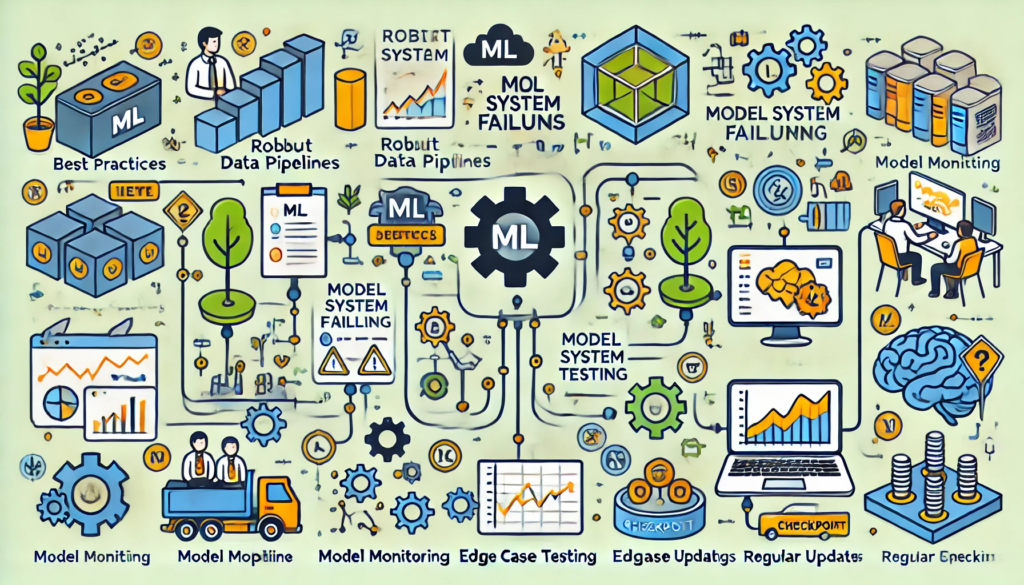comprehensive guide to the Causes of ML System Failures: Insights and Solutions 2024

Machine learning systems have become integral to modern industries, powering everything from recommendation engines to autonomous vehicles. However, like any software, ML systems are prone to failures. These failures can stem from operational breakdowns or issues unique to the machine learning lifecycle.
This blog explores the causes of ML system failures, distinguishing between traditional software failures and ML-specific challenges, while offering strategies for mitigation.
What is an ML System
http://What is an ML System Failure? Failure?

An ML system failure occurs when one or more expectations of the system are violated. Unlike traditional software, where failures typically involve operational metrics like latency and throughput, ML systems must also meet performance expectations, such as accuracy and robustness.
Example:
In an English-to-French translation system:
- Operational Expectation: Translations are returned within one second.
- ML Performance Expectation: 99% of translations are accurate.
Both expectations must be met for the system to be considered reliable.
Types of ML System Failures

Failures in ML systems can be categorized into two main types:
- Software System Failures
- ML-Specific Failures
1. Software System Failures
These failures are common to all software systems and are generally easier to detect.
Causes:
- Dependency Failures:
- Breakages in third-party software or libraries that the ML system relies on.
- Example: A Python library update causing API incompatibilities.
- Deployment Failures:
- Errors during deployment, such as using outdated model binaries or incorrect permissions.
- Hardware Failures:
- Issues like overheating CPUs or GPU malfunctions.
- Downtime or Crashes:
- Server outages causing system unavailability.
Solution:
- Use robust software engineering practices.
- Implement monitoring systems for dependencies and hardware health.
- Automate deployment pipelines to minimize errors.
2. ML-Specific Failures
These failures are unique to machine learning systems and are harder to detect because they often involve subtle performance issues.
Causes:
- Data Distribution Shifts:
- The real-world data distribution diverges from the training data, leading to degraded performance.
- Known as train-serving skew.
- Example: A fraud detection model trained on pre-pandemic data failing post-pandemic due to changes in transaction patterns.
- Edge Cases:
- Rare, extreme data samples that cause catastrophic errors.
- Example: Self-driving cars failing in unusual weather conditions.
- Degenerate Feedback Loops:
- Occurs when system outputs influence future inputs, reinforcing biases.
- Example: A recommender system showing the most clicked items, which biases future clicks.
Solution:
- Monitor model performance metrics in production.
- Regularly retrain models with updated data to address distribution shifts.
- Test models extensively on edge cases and adversarial samples.
- Break feedback loops by introducing diverse or random elements.
Key Challenges in Detecting ML Failures

- Difficulty in Measuring ML Performance:
- Unlike operational failures, ML performance violations require labeled data for evaluation.
- Example: Verifying a 99% translation accuracy rate requires ground truth labels for comparison.
- Complexity of Real-World Data:
- Training data is finite and curated, while real-world data is dynamic and often unstructured.
- Continuous changes in the environment introduce new challenges.
- Latent Issues in Training Pipelines:
- Changes in the training pipeline not mirrored in the inference pipeline can lead to inconsistencies.
Best Practices for Preventing ML System Failures
- Robust Data Pipelines:
- Automate data validation and preprocessing to ensure high-quality inputs.
- Version Control:
- Track versions for data, models, and code to ensure consistency and reproducibility.
- Model Monitoring and Alerts:
- Continuously monitor performance metrics like accuracy, precision, and recall.
- Set thresholds and triggers for drift detection.
- Test Against Edge Cases:
- Simulate edge scenarios during validation to identify potential failure points.
- Diverse Training Data:
- Collect and curate diverse datasets to reduce train-serving skew.
- Regular Model Updates:
- Periodically retrain models with new data to adapt to changes in the real world.
Future Trends in ML System Reliability
- AI for Monitoring:
- Leveraging AI to automate the detection of performance degradation or data anomalies.
- Adversarial Testing:
- Actively testing models against adversarial inputs to ensure robustness.
- Standardized Tooling:
- Emergence of tools and frameworks to streamline ML production practices.
- Improved Feedback Loops:
- Designing systems that mitigate bias reinforcement while incorporating user feedback effectively.
Conclusion
ML system failures can stem from traditional software issues or unique challenges inherent to machine learning workflows. By understanding the root causes and implementing best practices, organizations can build robust systems that not only meet operational expectations but also excel in performance metrics.
Ready to future-proof your ML systems? Start by addressing these failure points today!